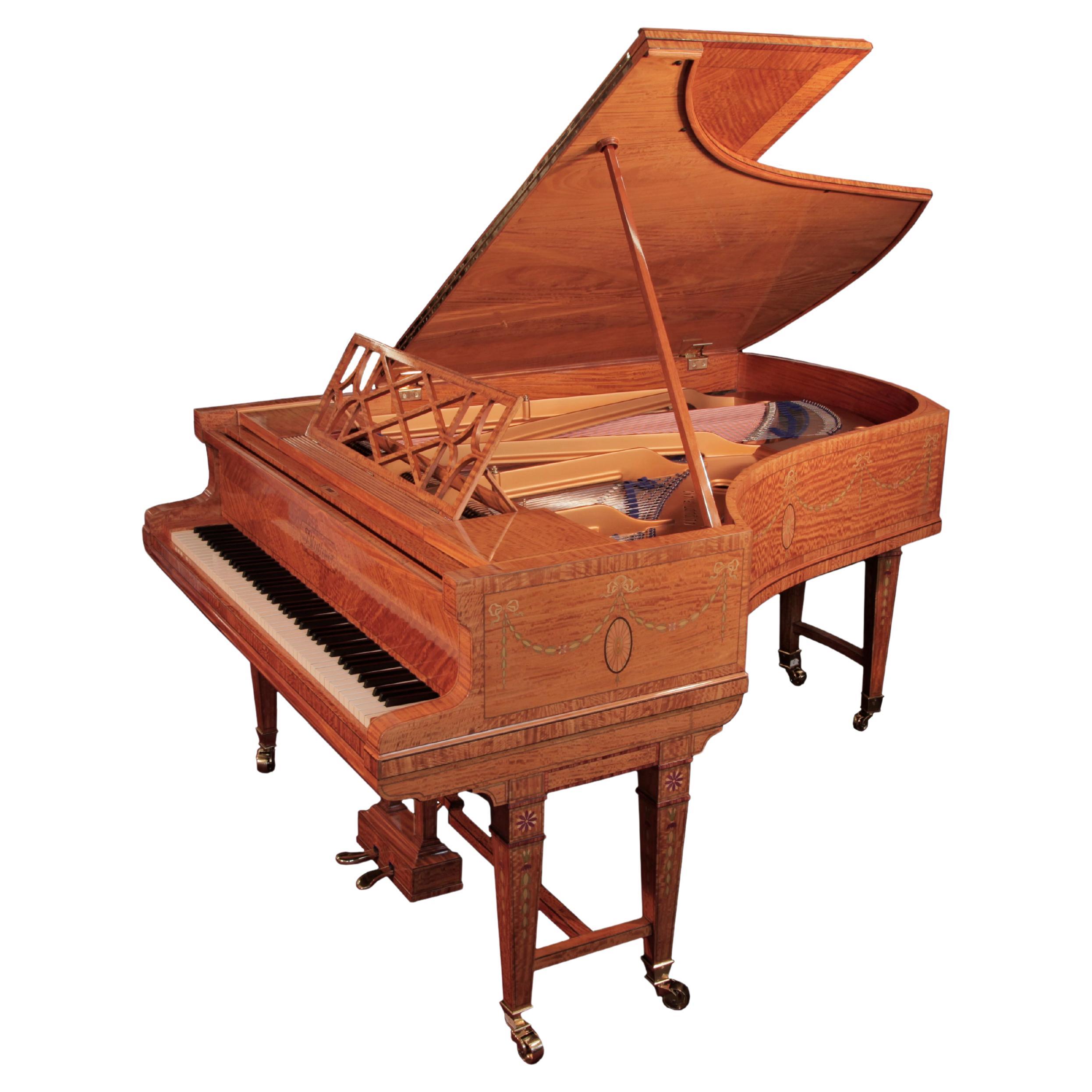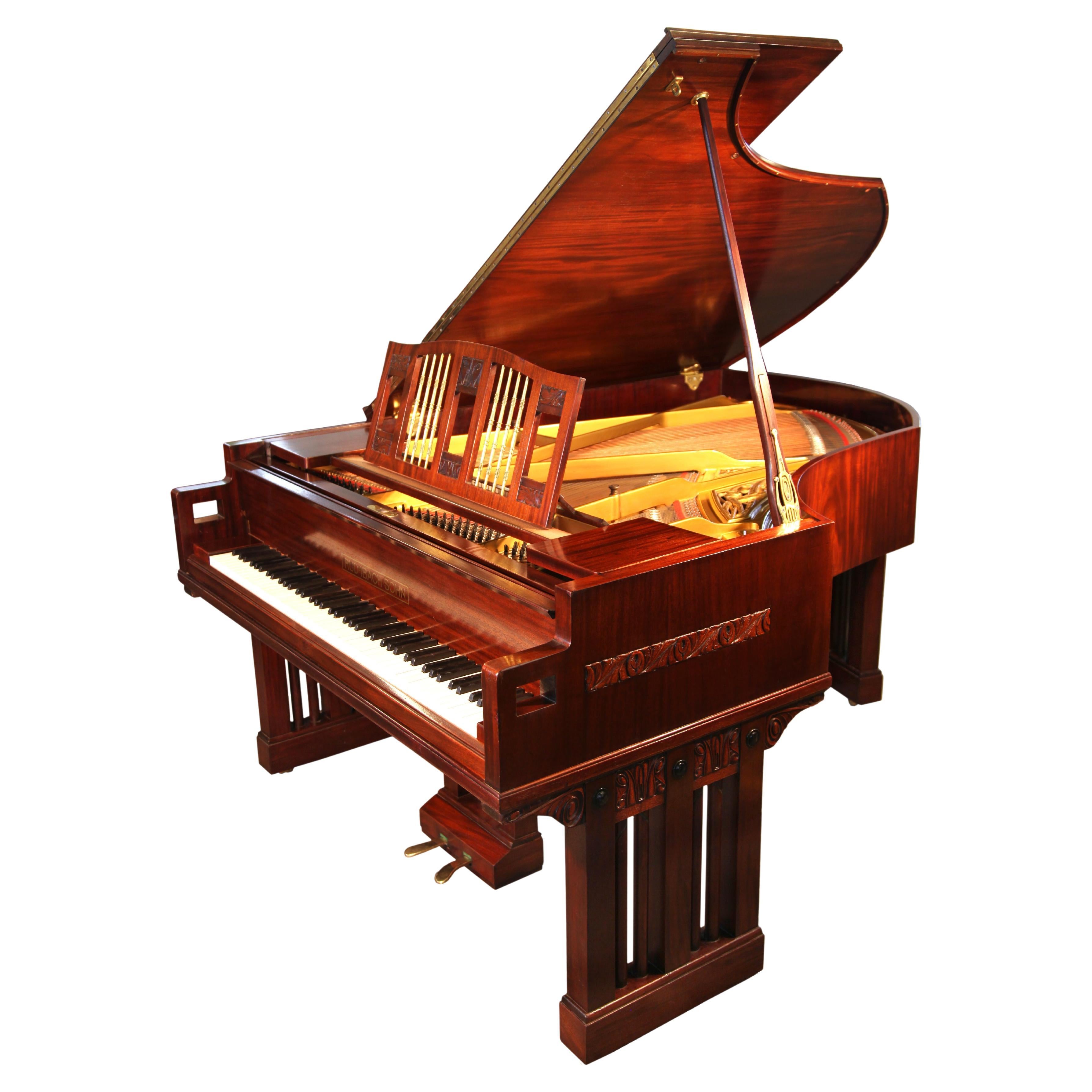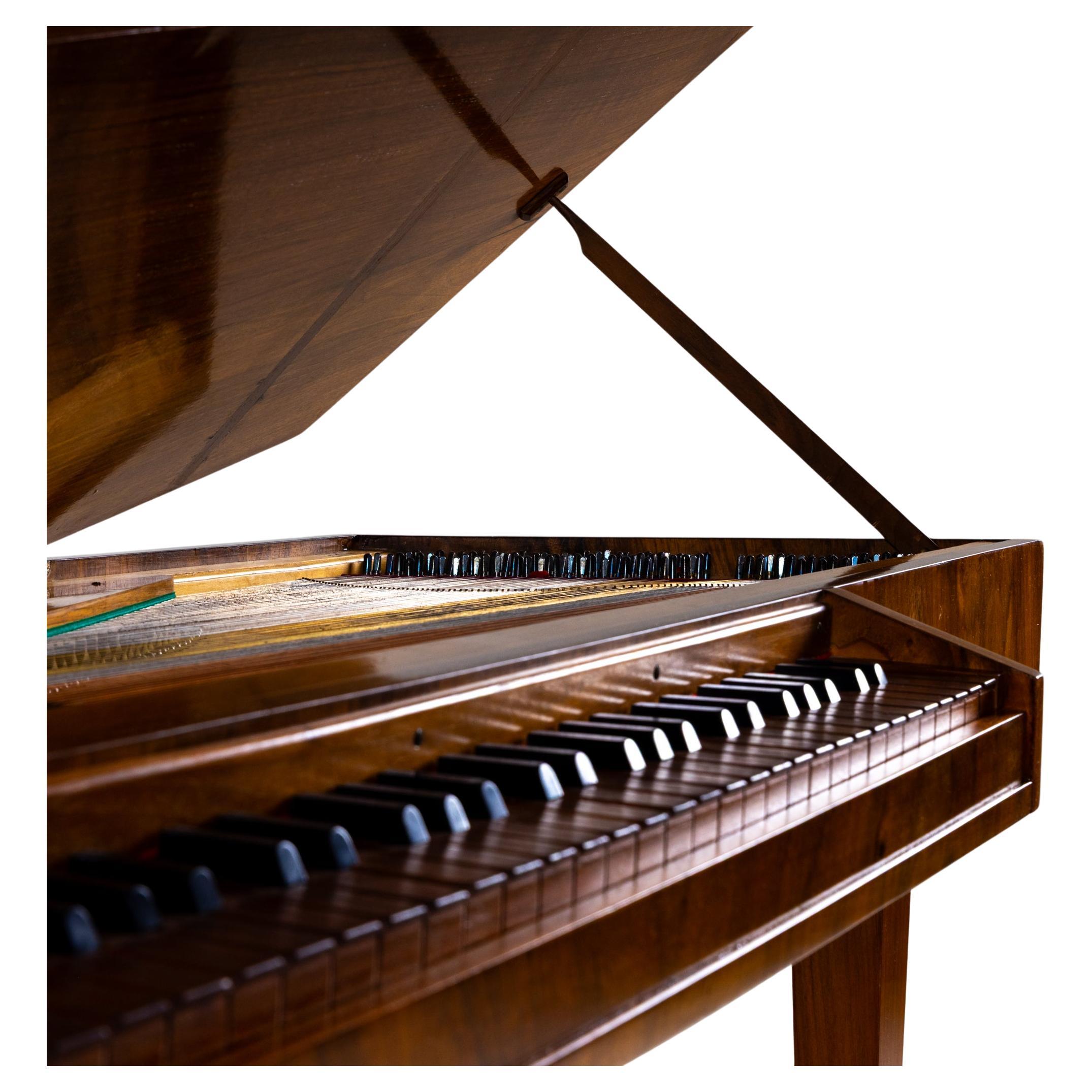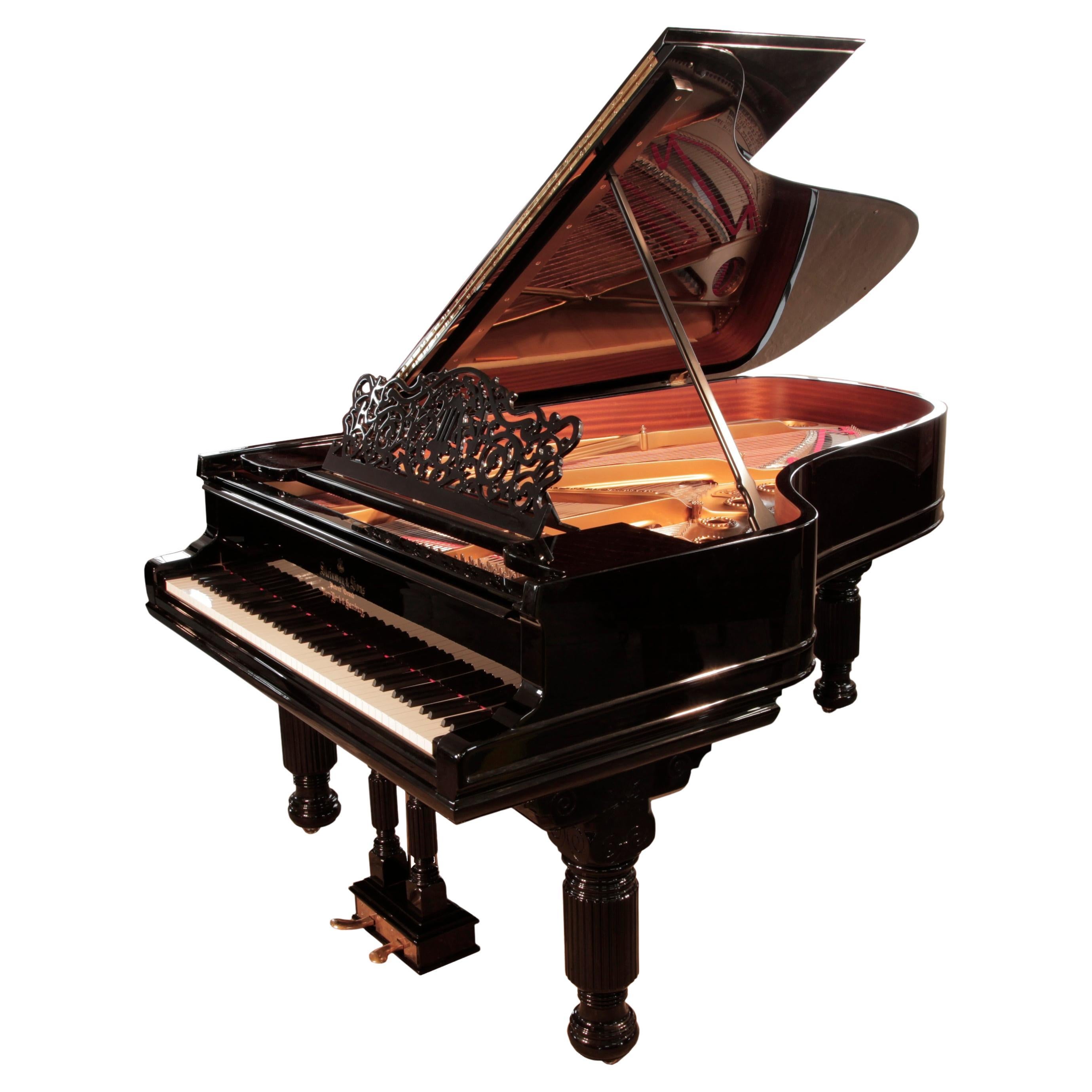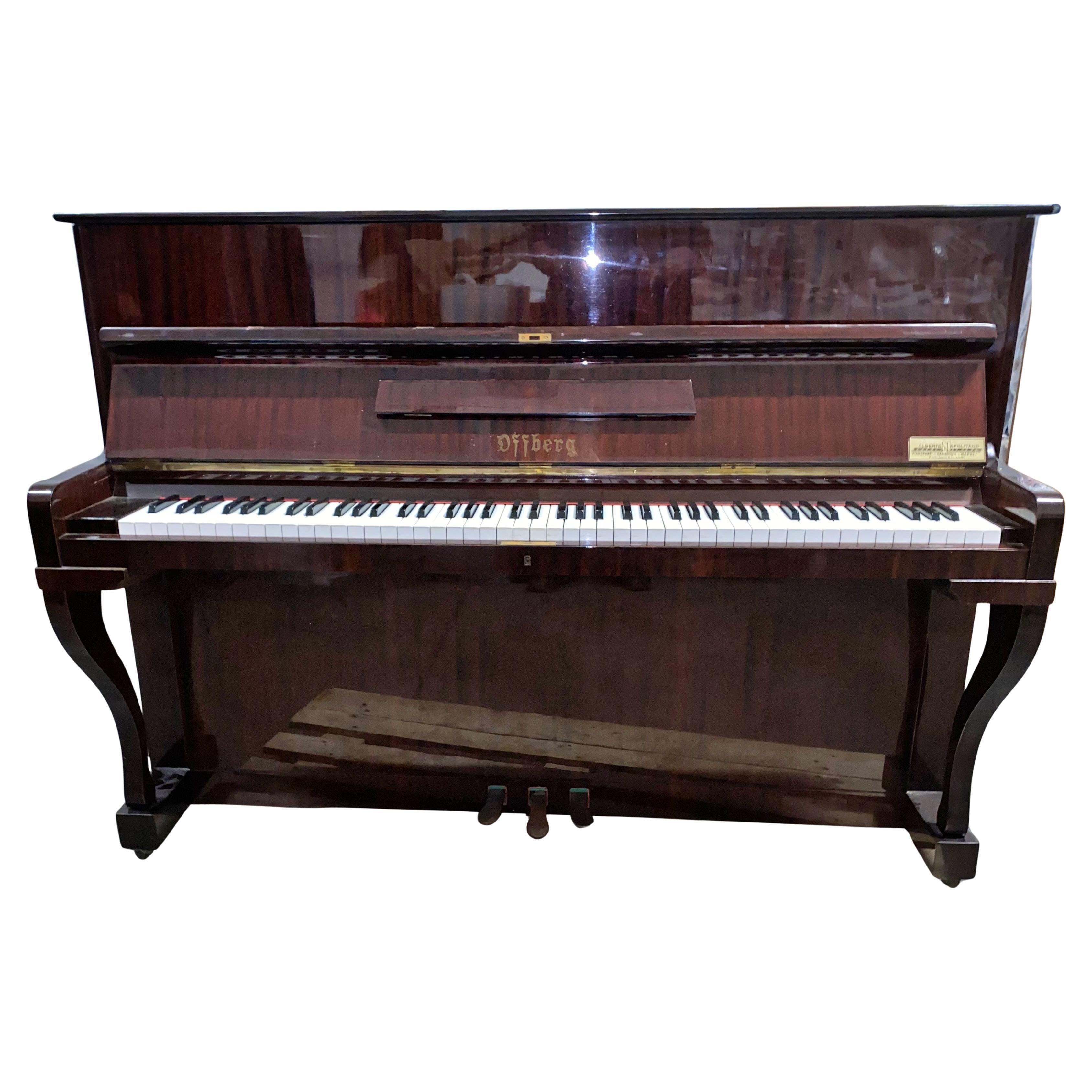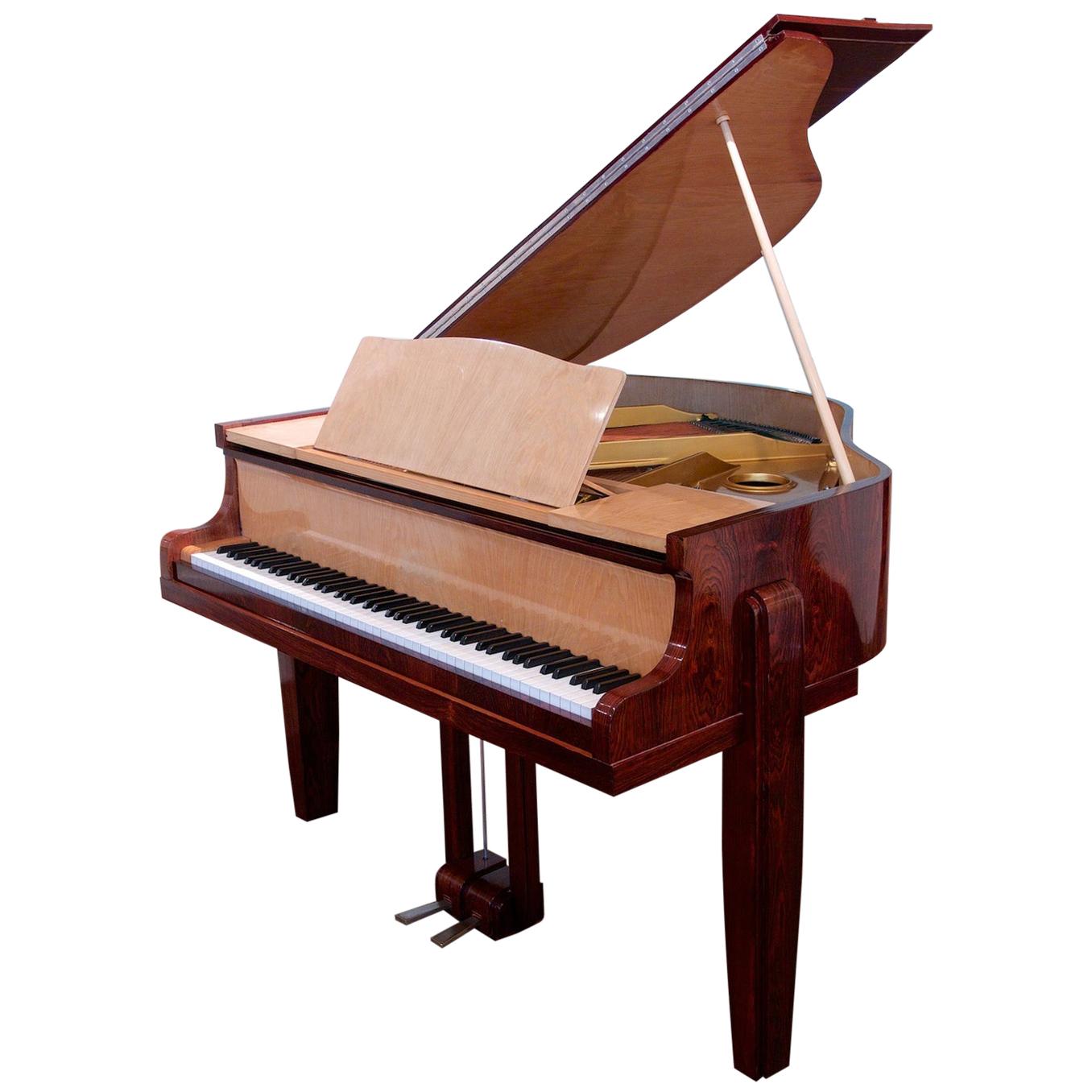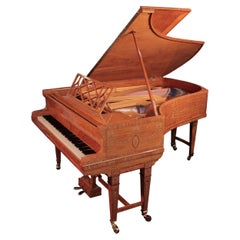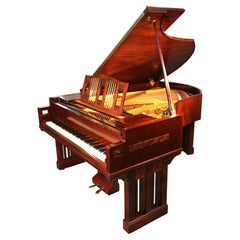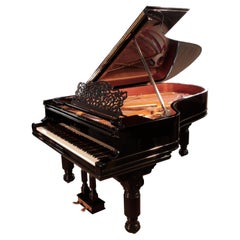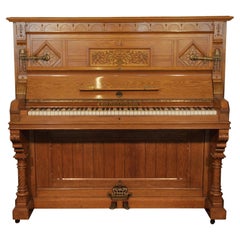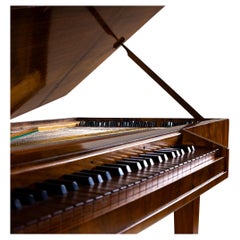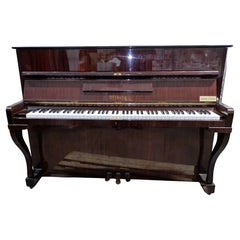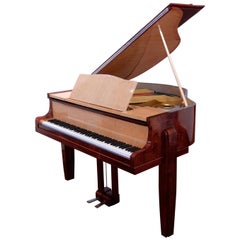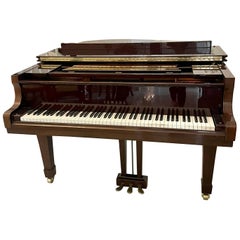Items Similar to Arts and Crafts Style Lipp Grand Piano Inlaid Germanic Folklore Motifs
Want more images or videos?
Request additional images or videos from the seller
1 of 17
Arts and Crafts Style Lipp Grand Piano Inlaid Germanic Folklore Motifs
$89,475.25
£65,000
€76,413.30
CA$123,774.16
A$136,407.71
CHF 71,413.96
MX$1,675,517.63
NOK 897,331.93
SEK 839,831.29
DKK 570,533.14
About the Item
Arts and Crafts style, Lipp grand piano for sale with a mahogany case inlaid with symbols and designs from Germanic folklore. Case features ornate brass hinges and slatted cross stretcher. The mahogany cabinet is polished in matt to emphasize the quality of the wood used. Cabinet features a simple geometric cross stretcher supporting the simple gate legs. The Arts and Crafts period championed the simplicity of form and the construction of the object. Here, the brass hinges are accentuated with two-tone brass and stamped geometric designs. Richard Lipp and Sohn was established in 1831 in Stuttgart, Germany.
The Lipp name is inlaid in a simple serif font. It is flanked by inlaid Norse symbols. The fylfot symbol, a four legged cross, is associated with fire and lightning and is holy to Thor.
The music desk is in a simple openwork design with cut-out slats. In the centre is an inlaid circle with central cross. A Norse symbol, this suggests the sun wheel, one of the oldest spiritual symbols of the Germanic people. The central cross separates the circle into four pieces, just like the seasons in a year. It is representative of life, fertility and peace.
Arts and Crafts objects were simple in form, without superfluous or excessive decoration, and how they were constructed was often still visible. Here the hinges, often hidden in modern furniture, are a strong element of the piano's design. The hinges are large and stamped with a circular design. Returning to Norse mythology, this symbol depicts the nine worlds, a symbol of Norse cosmology. In Norse cosmology the universe is divided into three realms;
The Upper Realm - made up of Asgard, Vanaheim and Alfheim, Middle Earth - made up of the ocean, Jotunheim and Svartalfheim, and The Land of the Dead - made up of Niflheim, Muspelheim and Hel. Further down the piano hinge is a criss-cross design which could also be symbolic of the Web of Wyrd which contains all the shapes of the runes in a matrix.
The Arts and Crafts Movement was an international design movement that flourished between 1880 and 1910. The movement stood for traditional craftsmanship using simple forms and often applied medieval, romantic or folk styles of decoration. It advocated economic and social reform and has been said to be essentially anti-industrial. It sought to reassert the importance of design and craftsmanship in all the arts in the face of increasing industrialization, which they felt was sacrificing quality in the pursuit of quantity. Arts and Crafts objects were simple in form, without superfluous or excessive decoration, and how they were constructed was often still visible. They tended to emphasize the qualities of the materials used. The movement was successful in raising the status of the craftsman and promoting respect for native materials and traditions.
Piano is restored.
- Dimensions:Height: 38.98 in (99 cm)Width: 55.52 in (141 cm)Depth: 71.66 in (182 cm)
- Style:Arts and Crafts (Of the Period)
- Materials and Techniques:
- Place of Origin:
- Period:
- Date of Manufacture:1910
- Condition:Refinished. Replacements made. Repaired: Piano has been fully restored. Piano has new hammers, felts, strings, dampers. Soundboard repaired and frame re-sprayed. Wear consistent with age and use. Instrument is restored.
- Seller Location:Leeds, GB
- Reference Number:Seller: Ref 18541stDibs: LU6879229751482
About the Seller
No Reviews Yet
Vetted Professional Seller
Every seller passes strict standards for authenticity and reliability
Established in 1979
1stDibs seller since 2022
5 sales on 1stDibs
- ShippingRetrieving quote...Shipping from: Leeds, United Kingdom
- Return Policy
Authenticity Guarantee
In the unlikely event there’s an issue with an item’s authenticity, contact us within 1 year for a full refund. DetailsMoney-Back Guarantee
If your item is not as described, is damaged in transit, or does not arrive, contact us within 7 days for a full refund. Details24-Hour Cancellation
You have a 24-hour grace period in which to reconsider your purchase, with no questions asked.Vetted Professional Sellers
Our world-class sellers must adhere to strict standards for service and quality, maintaining the integrity of our listings.Price-Match Guarantee
If you find that a seller listed the same item for a lower price elsewhere, we’ll match it.Trusted Global Delivery
Our best-in-class carrier network provides specialized shipping options worldwide, including custom delivery.More From This Seller
View AllAdams Style Bluthner Grand Piano Quarter Cut Satinwood Inlaid Swags and Bows
Located in Leeds, GB
Adams style, 1911, Bluthner grand piano with a french polished, quarter cut, satinwood case with boxwood stringing inlay and crossbanding accents. The satinwood veneer of the cabinet...
Category
Early 20th Century German Adam Style Musical Instruments
Materials
Brass
Arts and Crafts Ibach Grand Piano Mahogany Designed by Dutch Architect Cuypers
Located in Leeds, GB
A 1916, German Arts and Crafts, Ibach grand piano with a mahogany case and carved panel detail. The mahogany cabinet is polished so as to emphas...
Category
Early 20th Century German Arts and Crafts Musical Instruments
Materials
Brass
Rebuilt Steinway Model B Grand Piano Arabesque Music Desk Fluted Barrel Legs
Located in Leeds, GB
Rebuilt, 1886, Steinway Model B grand piano with a black case.
The music desk is in an openwork arabesque design featuring a central lyre motif
surrounded by stylised tendrils and foliage. The serpentine piano cheek features a dual linear case moulding. The piano lyre has two fluted spindle upright supports with two brass pedals and a brass footplate. The fluted, barrel piano legs have sunken brass casters. The leg pediment is carved with a stylised flower and curlicues. Piano has an eighty-five note keyboard.
Enjoy the vintage styling of an antique Steinway...
Category
Antique Late 19th Century German Musical Instruments
Materials
Brass
English Gothic Style Ibach Upright Piano Carved Oak Traditional Folk Art Motifs
Located in Leeds, GB
English Gothic style, 1895, Ibach upright piano with a carved, oak case and ornate brass candlesticks and handles. Cabinet features traditional folk art motifs and carvings.
Pilasters carved with hearts and stylised trees. Piano cheeks feature a carved sun in a half hex and stylised bird in flight.
Front panel inlaid with folk elements including trinity tulips symbolising faith, hope and charity in a central urn with stylised foliage.
Piano legs are turned with carved spiraling detail .
Piano pedals feature a raised, ornate brass footplate in a curlicue design.
Repeating, carved barrel vaults...
Category
Antique Early 19th Century German Gothic Revival Musical Instruments
Materials
Brass
Rebuilt Antique Steinway Model A Grand Piano Gloss Black Fluted Barrel Legs
Located in Leeds, GB
Rebuilt, 1895, Steinway Model A grand piano for sale with a black case.
The music desk is in an openwork, arabesque design of stylised foliage with ...
Category
Antique Late 19th Century German Musical Instruments
Materials
Brass
Chinese Chippendale Style Schiedmayer Piano Oriental Scenes Embossed Japanning
Located in Leeds, GB
Chinese Chippendale style, 1899, Schiedmayer grand piano with a flame mahogany case and Malborough legs with applied fret carvings. Cabinet features oriental scenes in embossed Japan...
Category
Antique Late 19th Century German Chinese Chippendale Musical Instruments
Materials
Wood, Mahogany
You May Also Like
Clavichord, 20th Century
Located in Greding, DE
Clavichord housed in a veneered walnut case of simple rectangular form. Numbered "284" on the inside. The instrument is currently un-tuned but remains in playable condition. A charmi...
Category
20th Century Modern Musical Instruments
Materials
Walnut
$3,344
Piano " Offberg " 20th Century
Located in Madrid, ES
Piano " Offberg " 20th century
150cm x 100cm x 55cm
walnut wood
good condition
Category
20th Century German Modern Musical Instruments
Materials
Walnut
Pierre-Paul Montagnac Modernist Piano
By Pierre-Paul Montagnac
Located in Philadelphia, PA
French Modernist Art Deco piano and bench by Pierre-Paul Montagnac, a variant of the model used in one of the luxe apartments, the Caen, on the great French oceanliner Normandie in 1935. Created in rosewood and sycamore, and carefully and correctly restored, including the fine Erard (#127208) instrument. 56” wide x 60” deep. Documented in numerous sources, including the July 1935 issue of Art et Decoration.
Pierre-Paul Montagnac
(1883-1961)
Born in Saint-Denis, France on 9 May 1883, Pierre-Paul Montagnac was equally talented as a fine artist and a decorative artist. He was educated in both disciplines, studying with Eugene Carriére as well as at the Académie de la Grande Chaumiére, both in Paris.
His inaugural exhibition was at the 1912 Salons – and at the 1920 Salon d’Automne he received a traveling scholarship. In 1918 he began working in the firm of André Mare and from 1922 collaborated with Maurice Dufrene at La Maîtrise, the famous design studio of Galeries Lafayette. From 1921 he exhibited at the Salons of la Société des Artistes Décorateurs, Salon des Architectes Modernes,
and internationally, in Barcelona and Leipzig. He designed suites on the grand French oceanliners, l’Atlantique, Normandie and Pasteur.
At the 1925 Paris International Exposition his work was in a standout class. At the 1937 Exhibition he organized the pavillion of the Artistes Decorateurs and personally won a Grand Prix. For the New York Exhibition in 1938, he was a member of the international jury, organized the group of Decorators, and, as architect, organized the exhibitions of jewelry and perfumes.
He became a member of the Society of Modern Architects and executed important and numerous architecture and decorating projects including the luxury apartments on the great French oceanliners l’Atlantique, Pasteur, and Normandie.
Vice President and then President of the Societe des Artistes Decorateurs from 1930-1938, he was also President of the Salon d’Automne and Vice President of the Committee of the Exhibition of Arts and Embellishments of Life; member of the steering committee of C.T.I. and Artistic Property, member of the Board of Directors of the Central Union of Decorative Arts. He was also an Officer of the Legion of Honor and received the Cross of War.
MONTAGNAC was the son of an engineer and he had a taste for geometry
and science that predisposed him to the rigors of architectural laws.
Multi-talented, he worked independently as a painter – who had
paintings acquired by the French government – while also working in
the related fields of architecture and decoration. His work included
homes, apartments, galleries, luxury shops, banks and the aforesaid
oceanliners.
As a designer/decorater, Montagnac had the taste for quality, luxurious
furniture, using precious woods, bronze extensions, ivory inlays, mother-of-pearl,
metal and coral. He advocated for a resolutely modern style and, free of all
pastiches, focused on beautiful cabinetry, the challenges of furniture design,
particularly from 1940 to 1945, captured all his attention.
The tireless activity of Montagnac, whose varied works are represented in
official museums and residences, was also recognized from a professional
and social point of view. He was a remarkable organizer, devoted to the
cause of art, to the defense of the trade and his colleagues. It was Montagnac
who, in 1939, with Anatole de Monzie, took the initiative to found the
ENTRAIDE to Artists (which provides support to talented young French artists).
MOBILIER ET DECORATION, September/October 1953
ERARD
An illustrious piano manufacturer, Sebastien Erard began building superior harpsichords in Paris in the mid-1700s, produced pianos for the French Court, and received a multitude of patents, many of which are still in use in piano manufacturing. Erard pianos were marketed as the finest pianos in the world and were owned by Queen Victoria, Franz Liszt, Chopin, Verdi, Ravel, and Felix Mendelssohn among many others. They continued to enjoy international success well into the 20th century. They were known for their unique sound quality, similar to the American square grand piano...
Category
Vintage 1930s French Art Deco Musical Instruments
Materials
Rosewood, Sycamore
Yamaha Baby Grand Quality Mahogany Piano Model C2
Located in Suffolk, GB
Quality Yamaha baby grand piano with an overstrung iron frame, frame and sound board in perfect condition, mahogany case standing on square tapering legs wi...
Category
Late 20th Century English Musical Instruments
Materials
Other
Antique Steinway & Sons Gold Bronze & Satinwood Baby Piano Circa 1910
Located in New Orleans, LA
This piano was made in the Hamburg Steinway & Sons factory and decorated in France. It is a beautiful instrument. As with most pianos, special shipping will be needed.
Category
Early 20th Century German Musical Instruments
Materials
Ormolu
Upright piano. Towards the beginning of the 20th century.
Located in Madrid, ES
Upright piano. Towards the beginning of the 20th century.
Upright or wall piano with a wooden body with marquetry elements on the central panel of the uppe...
Category
20th Century European Other Musical Instruments
Materials
Other
